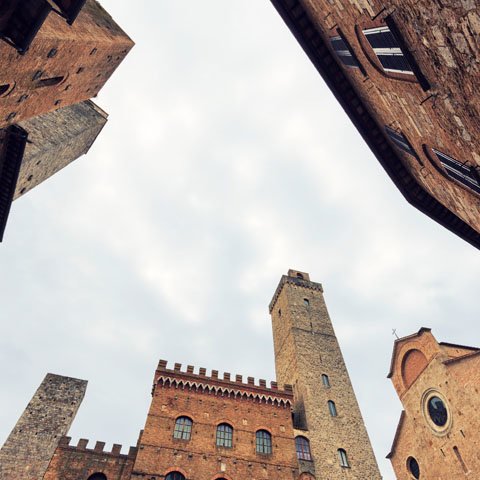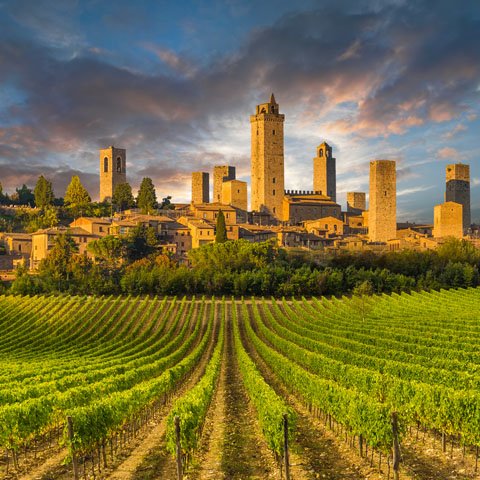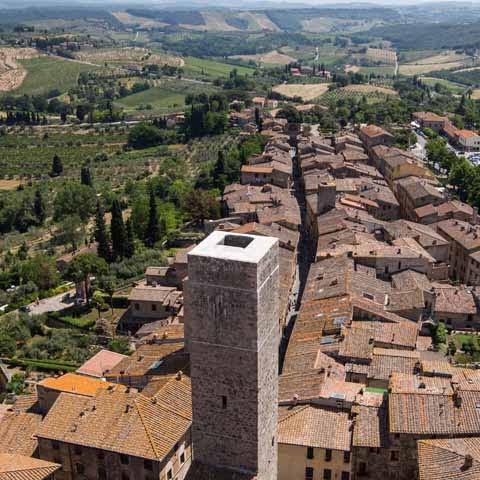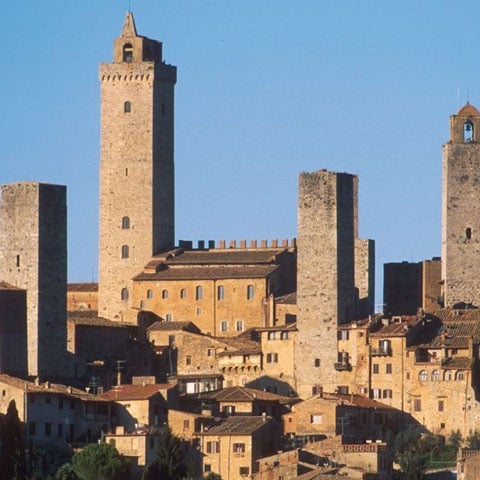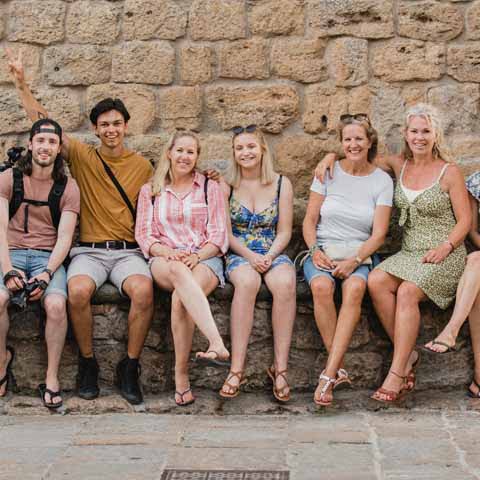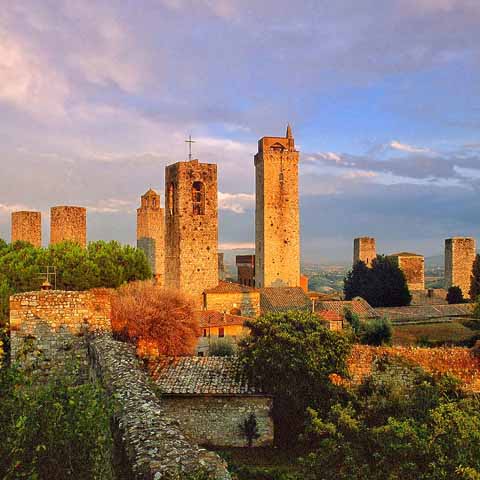San Gimignano is a charming medieval town nestled in Italy’s fascinating Tuscany region, more precisely in the province of Siena. It counts a little over 7,500 inhabitants and is famous for its characteristic medieval architecture.
The historic center is a UNESCO World Heritage Site due to the impressively-preserved buildings and towers dating back to the thirteen and fourteen centuries – one of the best examples of urban organization in Europe’s communal age.
But even if it is known for its medieval heritage, the origins of this settlement are lost in the mists of time. According to local legends, San Gimignano was founded by two young Roman patricians in 63 BC and had initially been called Silva, a name inspired either by the founder’s name – Silvio – or by the Latin word silva, which translates to forest, considering that the hills now occupied by the town were at the time covered in woods. But even if the legends have their charm, the truth is that people most likely settled in the region way before the Romans.
San Gimignano received its current name around the fifth century AD when the clergy present in the region named the settlement after a bishop of Modena from the fourth century AD. This choice was not casual; indeed, it is believed that the saint saved the city from the threat of Totila during the barbarian invasions.
Nowadays, San Gimignano is considered one of Italy’s best-kept secrets. Although a popular tourist destination, the atmosphere here is characterized by the authentic Italian style – slow rhythms, genuine products, and jaw-dropping scenery. Let’s find out more about San Gimignano’s history.
PREHISTORY OF SAN GIMIGNANO
San Gimignano’s history is not as old as that of other settlements in Italy but still goes back to at least the third century BC. Like most prehistoric settlements, the early civilizations began to establish themselves in the region due to the strategic position of the place, atop a hill overlooking Val d’Elsa.
However, the first civilizations did not leave many signs. Clear evidence of the settlement is seen from the Old Etruscan era when people began to settle themselves more permanently in the region.
Some of the oldest archaeological evidence comprises the sacred area of Pugiano located in the Riguardi Valley.
More recent vestiges belong to the Hellenic era and include sepulchral places as well as a few lone tombs still present in the Old Town.
While the first settlements only occupied the top of the hill, San Gimignano began to extend its borders during Roman colonization. Some of the most important Roman centers were established near the rivers, often serving to ensure a continuous flow of transport and trade.
HISTORY OF SAN GIMIGNANO
Although San Gimignano’s territory was inhabited since early prehistory, the Etruscans and Romans only established smaller villages around the bigger town of Volterra that were not actually grouped in a single center. Things changed in the Early Middle Ages when the Old Town of today’s San Gimignano was founded.
In 998, San Gimignano was still only a village, a fief giving the Bishop of Volterra access to the popular Via Francigena. The village only became a real town in the Late Middle Ages due to its strategic position. With the growth of population and the new importance it gained, the town was enveloped by a circle of fortified walls.
Due to its location on Via Francigena, San Gimignano quickly became one of the most important stops for travelers and pilgrims on their journeys from France to Rome.
Shortly after becoming a town, in 1199, San Gimignano was established into an independent entity governed by periodically elected consuls. However, this government was quickly abolished, with the council replaced by a Podestà.
For impartiality reasons, each Podestà of San Gimignano was always a foreigner and only ruled the town for a maximum of six months – perhaps a reason that contributed to limited growth despite the flourishing period the region was experiencing.
Nevertheless, this is the period when the town gained its characteristic towers – 14 of these symbols of power survived to this day, but originally, the town is believed to have hosted 72 towers, all constructed by rival families.
The first towers in San Gimignano were built farther away from the town center and were characterized by very thick walls with a few small windows as well as small rooms. This construction guaranteed warmth in winter as well as coolness in summer, while the additional buildings made from mud or wood housed the servants.
Both the shape and the location of these towers changed between the twelfth and thirteenth centuries when Pisa became the reference point in the region. These newer towers were characterized by larger rooms and windows, narrower but tall entryways, and the floors began to be separated by wooden lofts and galleries meant to improve livability.
Towers apart, the late twelfth century also revolutionized the way lower buildings were constructed, with most buildings in the town being inspired by the palaces seen in Florence and Pisa.
Indeed, while Florence, Pisa, Siena, and Lucca developed different architectural styles starting from 1250, San Gimignano was limited to absorbing elements from all these styles, giving birth to a one-of-a-kind early eclectic architecture.
This time of splendor and growth ended in the fourteenth century when the town entered into a period of crisis that began with internal struggles. Then, the town was severely hit by the Plague and famine, which decimated the population by 1348.
Like most towns and villages in the area, San Gimignano was also involved in the conflict between the Guelph and the Ghibellines – two factions supporting the Pope and the Holy Roman Emperor, respectively.
Exhausted by all these negative events, San Gimignano surrendered spontaneously to Florence in 1351. Giving up its autonomy as well as the important political role in the Tuscan region, San Gimignano became part of the Republic of Florence officially in 1354.
As a result of this change, San Gimignano entered an era of progressive decay, including poverty, pestilence, a dramatic loss of economic activities, and, consequently, a decrease in population that lasted for centuries.
Despite its persistent economic and political decline, the town’s inclusion into the Republic of Florence brought an important architectural and artistic richness. One of the most important buildings dating back to that era is the Rocca of Montestaffoli fortress, and in 1358, San Gimignano also built reinforced town walls.
Throughout the fourteenth and fifteenth centuries, numerous artists from Siena and Florence also created impressive works of art, most of them commissioned by clergy. Some of the most important artists who contributed to the town’s medieval heritage include Taddeo di Bartolo, Piero del Pollaiolo, Memmo di Filippuccio, Federico Memmi, Lippo Memmi, Benozzo Gozzoli, Sebastiano Mainardi, and Domenico Ghirlandaio.
Perhaps the best thing that came out from this otherwise grim period of marginalization was the almost untouched crystallization of the medieval aspect – the exact thing San Gimignano is now famous for. However, this period of decline lasted throughout the sixteenth century.
At the beginning of the seventeenth century, San Gimignano was nothing more than one of the many rural areas of the Grand Duchy of Tuscany, and it remained a mere village for most of the eighteenth and nineteenth centuries as well.
The Unification of Italy found San Gimignano in the same period of lethargy. Nevertheless, during the Plebiscite of 1860 for the annexation of Tuscany to the new kingdom, most people in San Gimignano voted against it. Despite their strong opposition to the annexation, though, the settlement had to follow the rest of the Tuscany and joined the Kingdom of Italy.
From then on, the uniqueness and beauty of the town began to be rediscovered, and in 1929 it became subject to monumental restrictions – perhaps the thing that kept it almost intact throughout World War II. However, this does not mean San Gimignano did not suffer any losses during the war. American bombings did, indeed, destroy the bell of Torre Grossa, though it was later rebuilt. Part of the cathedral also collapsed during these events, and a house in the main square was completely destroyed.
Apart from the architectural loss, of course, some citizens of San Gimignano perished as a result of the war, while many were also injured.
Like most settlements in Tuscany, San Gimignano regained its confidence and rebuilt or restructured most of its buildings following the war. In 1990, the Old Town was declared a World Heritage Site by UNESCO, and today, it bases its economy mostly on tourism and winemaking.
ARCHAEOLOGY IN SAN GIMIGNANO
Castelvecchio di San Gimignano is one of the most important archaeological sites in the territory. Dating back to the Etruscan era, it is believed to be erected on a sacred hill. Artifacts discovered in the territory are exhibited at the Archaeological Museum of Siena, and there is scarce evidence from the other eras, mainly because this original center was abandoned by the Romans who built a new village closer to Via Francigena. Most of the ruins present on the site today have medieval origins.
Another important site is Villa Romana di Aiano, an archaeological site near San Gimignano. Most of the buildings and artifacts discovered here date back to the Roman era, including a full neighborhood of Roman villas erected between the fourth and fifth centuries AD.
This site is particularly important due to the period when the buildings were erected, corresponding to the last centuries before the collapse of the Roman Empire in the fifth century AD. Some of the buildings found here survived particularly well across the centuries, allowing visitors to view artifacts including a beautifully preserved jar, as well as mosaics and frescoes on the villa walls.
Archaeological artifacts found around the town area are now exhibited in the Civic Museum of San Gimignano, as well as in other archaeological museums in Siena, Volterra, and Florence.
Travel Guides
The Tuscany Region of Italy
The Cities of Tuscany, Italy
